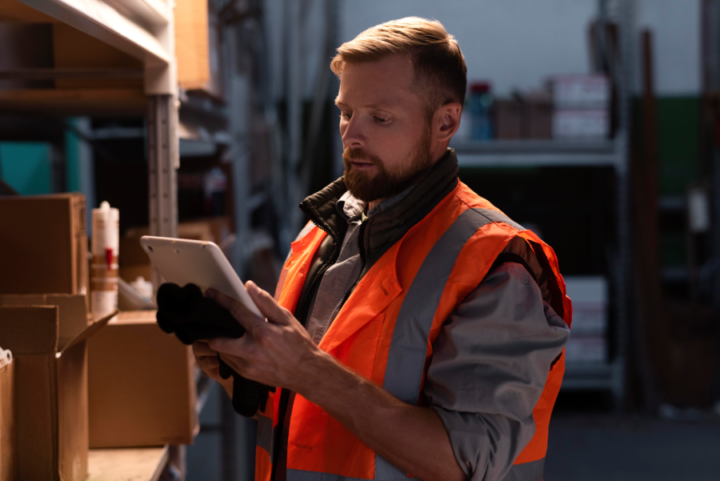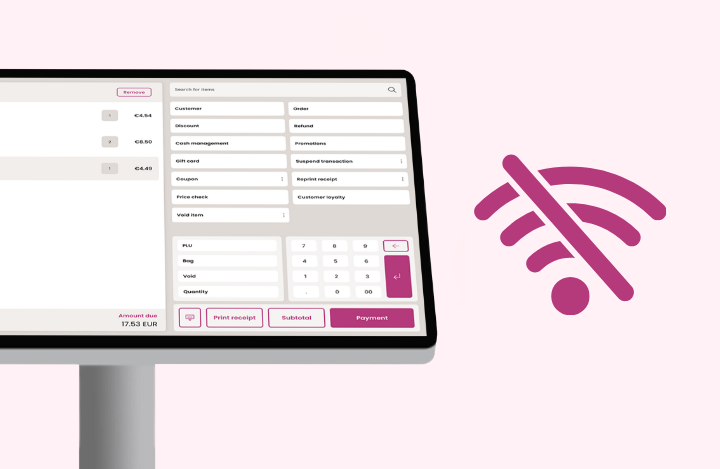ERP and POS integration: what it is and why it matters for retailers
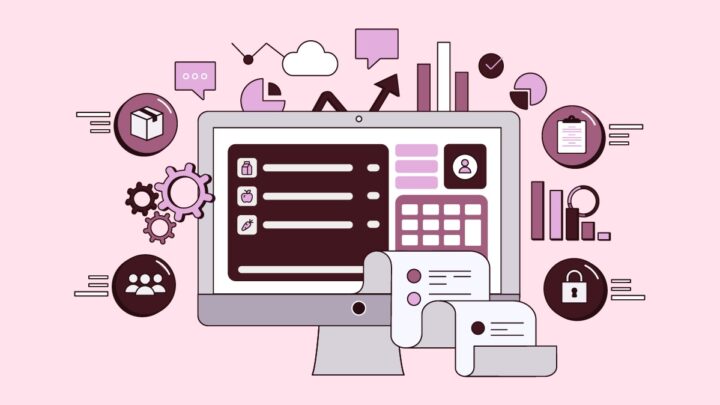
ERP and POS integration: vital for modern retailing
Unlocking seamless operations through system integration
Navigating the setup of any IT infrastructure can be overwhelming - it’s particularly tricky figuring out how your technology pieces should fit together for optimal operations. Even more complicated is when you onboard a new system - such as a Point of Sale (POS) - and want to integrate it with the rest of your tech stack, such as your Enterprise Resource Planning (ERP) software.
That’s exactly what this post aims to solve. At the end of this quick-fire article - approximately 15 min read - you’ll understand what ERP and POS systems are, be able to spot the signs of a robust integration (with a focus on real-time data, clean master data management and synchronization), and know why Hii Retail checks all those boxes.
Whether you’re exploring new systems or evaluating whether your current stack is up to the job, this post will help you assess what counts as an integrated and scalable ERP-POS setup.
ERP and POS: the basics
ERP and POS systems are essential for any business to run smoothly. Though they serve different purposes, when they integrate seamlessly they become the foundation of a highly efficient, data-driven operation.
What is ERP?
ERP stands for Enterprise Resource Planning. It refers to the software systems that handle all the essential, behind-the-scenes workflows of a business: for example inventory, purchasing, finances, supply chain, order fulfilment and customer data. An ERP system centralizes all of these functions, feeding in business data from all corners of the business and providing a single source of truth.
Did you know?
In 2023, 86.3% of large EU enterprises reported using ERP.
What is POS?
POS is short for Point-of-Sale. This system manages everything related to transactions: for example, the cash register, in-store terminals, item scanning, payment processing, returns, etc. Traditional POS systems would simply process individual transactions, however, modern POS systems now go much further than this, offering real-time inventory tracking, insights into customer loyalty and behavior, and data on sales trends.
Did you know?
Europe’s POS software market is expected to grow at a CAGR of 9.3% from 2024 to 2030.
Horizon Databook: Europe Point-of-sale Software Market Size & Outlook
How does an ERP and POS integrate?
When someone talks about ERP and POS integration, what they’re referring to is the technical and operational coupling of the POS system with the ERP system, so that data flows effortlessly between the front-end (store, checkout) and back-end (finance, inventory, procurement).
How integration works & what it brings:
With integration of these two systems, business information from the POS is pushed into the ERP at lightning speed, often in real-time, while master data maintained in the ERP (or other central systems) is accessible to the POS. That two-way data exchange means:
Patchy integration: the risks and business impact
If your ERP and POS live in siloes and don’t share information, efficiency suffers:
❌ Teams spends hours or days matching POS transactions to ERP financials
❌ Stock levels shown in the ERP are outdated and unreliable
❌ Customer experience suffers - e.g. loyalty programs not syncing with recent purchases, slow returns process, issues with click-&-collect, incorrect stock status on e-commerce sites
❌ Regulatory or tax compliance issues
❌ Reduced responsiveness to market changes
Patchy integrations could be damaging your customer experience.
Hii Retail POS + ERP integration: future-proofing your business
Below are 8 ways Hii Retail delivers best-in-class ERP integration.
1. Flexible data ownership configurations
Some data (such as transactions, receipts, store hierarchies, promotions) can be mastered in Hii Retail - whereas other data (such as products, customers, prices, store metadata) can be maintained in ERP, CRM, or MDM, depending on what the retailer already uses.
This flexibility means Hiii Retail easily harmonizes with a retailer’s existing enterprise landscape - they can keep using systems they already trust, avoid unnecessary data duplication, and maintain clear ownership over what data lives where.
2. Two different integration patterns
ERP integration use cases can follow two different integration patterns:

Pattern 1: Master data (product, pricing, store information) is replicated to Hii Retail via REST APIs. System checks data for completeness (e.g. ensuring items have pricing) and signals issues over webhooks if data is missing or invalid.
Pattern 2: Transactions and other event-type data (sales, returns) is exported from Hii Retail using webhooks, so downstream systems (such as an ERP) receive the data reliably.
3. Checkout Hub microservices
Hii Retail uses a “Checkout Hub” of microservices as the integration layer. This acts as the bridge between Hii Retail and back-office/master data systems such as an ERP.
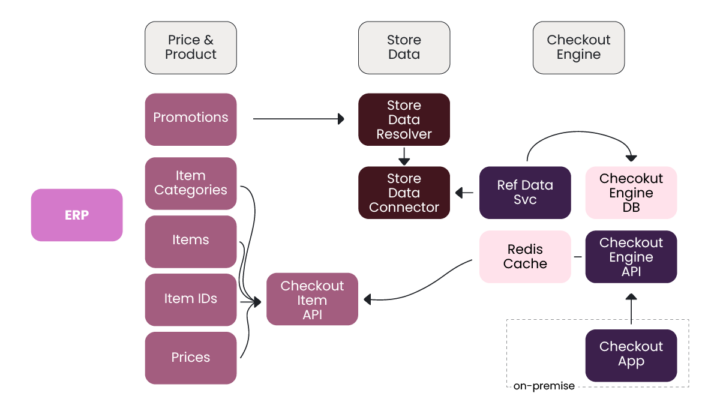
This hub manages the flow of master data downstream to the stores (e.g. item catalog, prices, promotions), and also sends upstream data (transaction logs and operational data) back to central systems.
This powers a seamless, reliable data transfer back and forth across the entire retail chain, ensuring data consistency, compliance and operational efficiency.
4. Ultra-fast load performance and synchronization
Hii Retail’s cloud-native POS, built on Google Cloud Platform (GCP), syncs seamlessly with ERP systems to deliver ultra-fast data updates and transaction processing. Most product or price changes appear in under 30 seconds, and sales data flows in near real-time, even at high volumes. This speed and scalability let retailers instantly adjust stock, easily spot trends, and optimize promotions without missing a beat.
5. Change & Activation Service
Hii Retail POS has the ability to let retailers control when updates go live in their stores via its cutting-edge Change & Activation Service - this is a feature most ERPs won’t provide. For example, a price change can be blocked until a manager approves it, ensuring signage is updated beforehand and staff are ready.
The Change and Activation Service prevents errors, keeps stores consistent and ensures that ERP-driven updates (like product info or pricing) are safely applied to the POS without disrupting operations.
6. Event-driven architecture
All transactions and updates from Hii Retail POS are sent instantly to a retailers’ ERP and other systems via events and webhooks. This includes sales, returns, inventory movements and customer interactions.
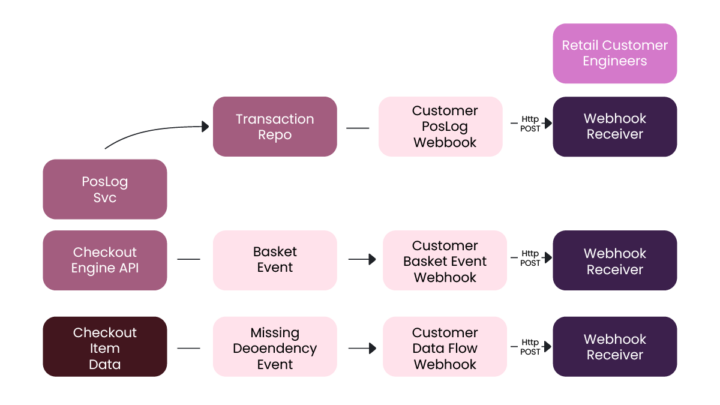
By enabling continuous data updates and immediate reflection of changes, this event-driven architecture minimizes synchronization time across the entire retail ecosystem. Consequently, retailers get up-to-the-second visibility across stores and back-office systems, enabling faster decisions, accurate accounting and better stock management.
7. Aggregated Accounting Service
Hii Retail’s Aggregated Accounting Service automatically transforms raw POS transaction data into structured General Ledger entries, ensuring it’s ready for use in ERP and accounting systems.
By applying retailer-specific rules for sales, VAT, payments and expenses, it streamlines financial reporting and reduces errors for retailers. Data is synced in real-time via webhooks, keeping ERP systems updated and fully aligned with store operations. Even during offline periods or system disruptions, checkouts can continue running smoothly, with all data automatically synchronizing once connectivity is restored, ensuring business continuity and operational efficiency.
8. GCP: for scalability and security
Hii Retail, built on Google Cloud Platform, grows with your business and supports omnichannel expansion. Its enterprise-grade security and advanced monitoring ensures all sensitive customer and sales data is shared safely and reliably across both systems. This seamless ERP integration offers retailers complete visibility, more accurate reporting and uninterrupted operations - even during peak times or outages.
Conclusion
Strong, seamless integration between ERP and POS systems means that retailers move from operating in a reactive and fragmented way to running lean, responsive, data-led businesses.
When POS and ERP are working together in real time, you unlock:
- Faster, more reliable decision-making
- A reduction in manual data entry, unreliable information and human errors
- Unrivalled unified commerce experiences for customers
- The ability to scale - knowing your data is accurate and secure

